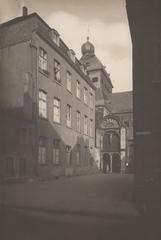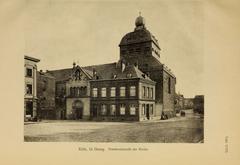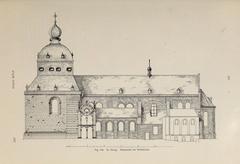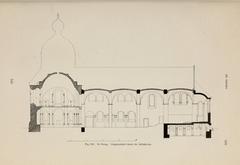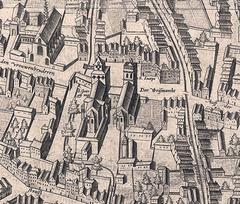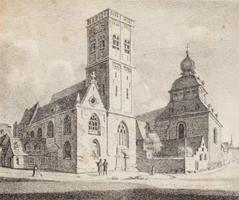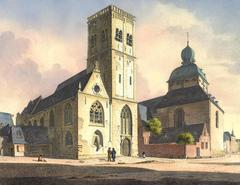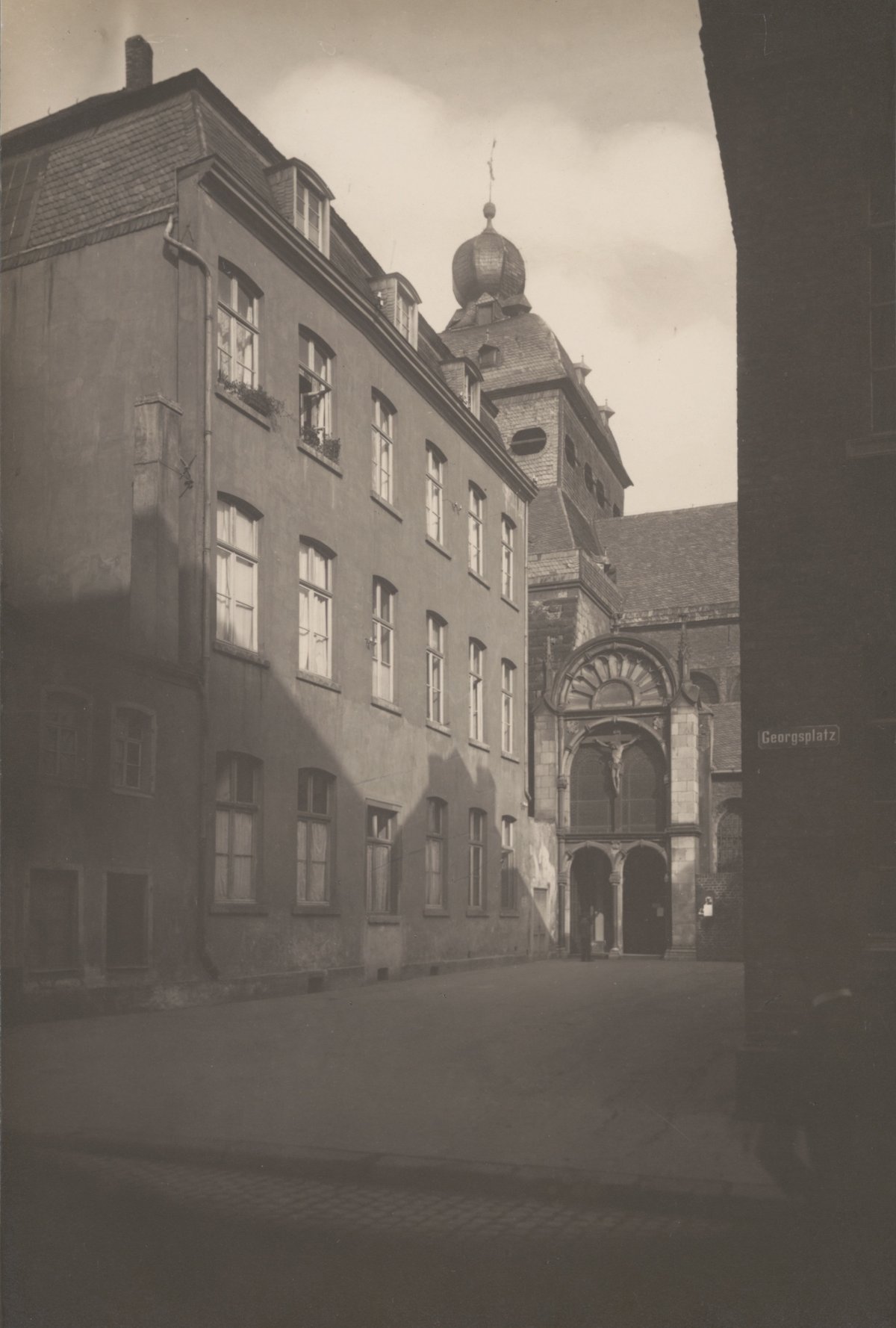
St. George’s Church Cologne: Visiting Hours, Tickets, and Historical Significance
Date: 15/06/2025
Introduction
St. George’s Church (St. Georg) in Cologne stands as a monument to the city’s Romanesque heritage and Christian traditions. Founded on the remnants of a Roman military site, its origins date to the 4th century, with the establishment of the Caesarius Oratory. This evolved into a collegiate basilica, consecrated in 1067 under Archbishop Anno II. Today, the church is celebrated for its architectural integrity, distinctive trefoil eastern end, and its role as a vibrant cultural and religious hub in Cologne’s historic southern district. Visitors can expect an immersive experience that weaves together history, art, spirituality, and community (fabriziomusacchio.com; Spotting History; wikipedia).
Historical Overview
Roman Foundations and Early Christian Development
St. George’s Church occupies a site of continuous significance since Roman times. Established near the southern gate of ancient Cologne, the area functioned as a military post controlling a key route between Cologne and Bonn (fabriziomusacchio.com). Between the 4th and 7th centuries, the Caesarius Oratory—constructed using Roman spolia—served as a Christian place of worship. The oratory was likely destroyed during the Norman invasions of the late 9th century, with archaeological finds later revealing remnants beneath the church’s crossing (kurby.ai).
Collegiate Chapter and Romanesque Construction
In 1059, Archbishop Anno II established a collegiate chapter at the site. The new Romanesque basilica, consecrated in 1067, featured a three-aisled layout, transept, three apses, and a crypt supported by Roman-era columns—elements that define its architectural identity (wikipedia). The collegiate chapter became influential, overseeing neighboring parishes and solidifying the church’s regional importance (fabriziomusacchio.com).
Architectural Evolution and Features
St. George’s Church is an exemplar of Romanesque architecture, with a trefoil apse, robust westwerk, and column-supported nave arcades distinguishing it from its contemporaries. The nave was vaulted and clerestory windows enlarged in the 12th century, while later centuries brought additions such as the northern portal in 1551 (germanytravel.blog). The crypt, divided by ancient columns, links the medieval church to Cologne’s Roman roots.
Religious and Cultural Significance
The translation of a St. George relic to the church by Anno II elevated its spiritual status. As one of Cologne’s twelve Romanesque churches—collectively called the “Hillige Stadt” (Holy City)—St. George’s is a vital link between the city’s Roman, medieval, and modern identities. It serves as a repository of art and memory, attracting visitors worldwide (culturethemes.com).
Wartime Destruction and Restoration
World War II brought extensive damage to St. George’s Church, destroying roofs, vaults, and much of the interior. Restoration began in the 1950s, led by Wilhelm Hartmann and Willy Weyres, with a focus on reviving the Romanesque character and integrating modern elements like Jan Thorn Prikker’s stained-glass windows. Further renovations in the early 2000s restored the interior and added contemporary liturgical furnishings (fabriziomusacchio.com).
Visiting St. George’s Church: Practical Information
Location and Accessibility
St. George’s Church is centrally located in Cologne’s southern Old Town and is easily accessible by public transport. The Severinstraße tram stop (lines 3, 4, 16, 17) is nearby, with additional stops at Waidmarkt and Heumarkt (Cologne Tourism). The area is pedestrian-friendly, close to the Rhine promenade, Old Town, and other museums.
Visiting Hours
- Monday–Saturday: 10:00 AM – 6:00 PM
- Sunday: 1:00 PM – 5:00 PM
- Note: Hours may vary during holidays and special events. Always check the official tourism website for current information.
Tickets and Admission
- Admission: Free
- Donations: Welcomed to support preservation.
Guided Tours
- Guided tours can be arranged in advance through the parish office or Cologne tourism agencies.
- Self-guided brochures and audio guides are typically available at the entrance.
Visitor Facilities
- Accessibility: Step-free entrance, ramps, and accessible restrooms. Some historic areas (e.g., crypt) may be less accessible.
- Restrooms: On-site, though limited.
- Photography: Allowed without flash or tripods; please be respectful during services.
Highlights of St. George’s Church
Architectural Details
- Exterior: Romanesque fortress-like appearance with thick stone walls, rounded windows, a square west tower, and minimal ornamentation (Trip.com).
- Interior: Central nave flanked by aisles, separated by columns and rounded arches. The nave features a flat wooden ceiling, while the apse is elevated and illuminated by high-set windows.
- Crypt: Supported by Roman spolia, accessible during special events or guided tours.
- Stained-Glass Windows: Modern reproductions of Jan Thorn Prikker’s 1920s designs, blending Romanesque tradition with expressionist art (Spotting History).
- Liturgical Furnishings: Romanesque baptismal font, medieval altars, and choir stalls.
Community and Culture
St. George’s is an active parish, hosting regular Catholic services, weddings, baptisms, and community concerts. Special events like the feast of St. George on April 23 and music recitals enhance the cultural atmosphere.
Travel Tips
- Best Times to Visit: Weekday mornings and late afternoons for a quieter experience.
- Dress Code: Modest attire recommended.
- Nearby Attractions: Cologne Cathedral, St. Maria Lyskirchen, St. Maria im Kapitol, and the Roman-Germanic Museum.
- Amenities: Cafés, bakeries, shops, ATMs, and tourist info points are nearby.
- Safety: Cologne is safe; keep an eye on personal belongings.
Practical Recommendations
- Use public transportation due to limited parking and city center traffic.
- The KölnCard offers discounts for attractions and transport.
- English is widely spoken; signage is bilingual.
Frequently Asked Questions (FAQs)
Q: What are the current visiting hours for St. George’s Church?
A: Generally 10:00–18:00 Monday to Saturday, 13:00–17:00 Sunday. Check for updates online.
Q: Is there a ticket required for entry?
A: No, admission is free; donations are appreciated.
Q: Is the church accessible for visitors with disabilities?
A: Yes, with step-free access to the nave and accessible restrooms. Some areas may be limited.
Q: Are guided tours offered?
A: Yes, by prior arrangement. Self-guided materials are usually available.
Q: Can I take photos inside?
A: Yes, but avoid flash and tripods, especially during services.
Q: What’s the best way to get there?
A: Take public transport to Severinstraße, Waidmarkt, or Heumarkt stops.
Conclusion
St. George’s Church Cologne is a vital link to the city’s Roman, medieval, and modern identities. Its architectural harmony, spiritual atmosphere, and cultural vibrancy make it a must-visit for any traveler seeking to explore Cologne’s historical sites. With free admission, accessible location, and a welcoming environment, St. George’s invites visitors to experience the city’s rich past and living traditions. Enhance your visit with a guided tour or the Audiala app for in-depth audio insights.
Plan your visit to St. George’s Church and discover the timeless spirit of Cologne’s Romanesque heart.
References
- Visiting St. George’s Church Cologne: History, Tickets, and Must-See Highlights, 2024, Fabrizio Musacchio
- Visiting St. George’s Church in Cologne: History, Tickets, and Travel Tips, 2024, Spotting History
- St. George’s Church, Cologne, Wikipedia
- Visiting St. George’s Church Cologne: Hours, Tickets, and Architectural Highlights, 2024, Germany Travel Blog
- Visiting St. George’s Church Cologne: Hours, Tickets, and Architectural Highlights, 2024, Trip.com
- Visiting St. George’s Church Cologne: Hours, Tickets, and Architectural Highlights, 2024, ArchDaily
- St. George’s Church Cologne: Visiting Hours, Tickets, History & Tips, 2025, Cologne Tourism
Images
- Exterior view of St. George’s Church Cologne (alt=“St. George’s Church Cologne exterior”)
- Interior showing Roman columns and nave arcade (alt=“Interior of St. George’s Church Cologne”)
- Stained-glass windows by Jan Thorn Prikker (alt=“Stained-glass windows in St. George’s Church Cologne”)
- Crypt supported by Roman columns (alt=“Crypt of St. George’s Church Cologne”)
Internal Links
For more information and travel inspiration, download the Audiala app and follow us on social media for updates on Cologne’s cultural events and historical landmarks.
